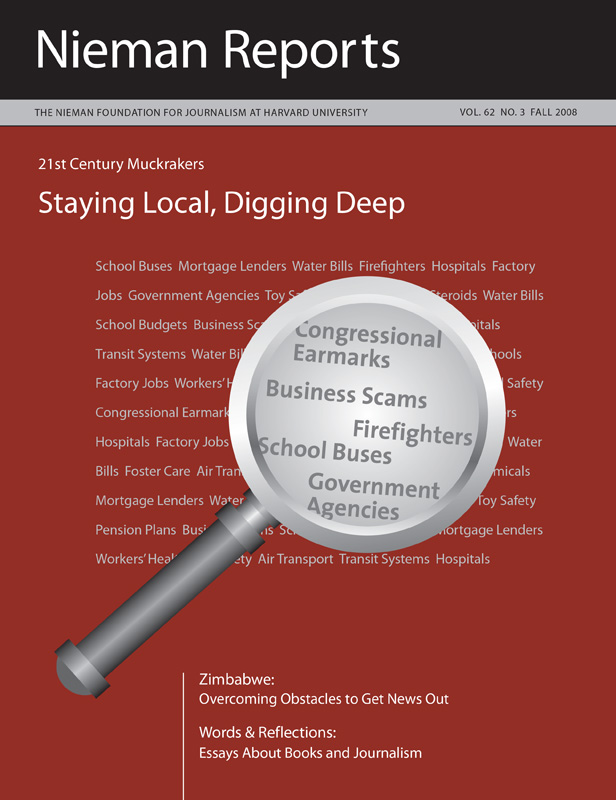
The Star-Telegram published investigative stories about public employee pensions in Texas. Firefighter Gene “Shakey” Holder, who worked with the Irving Fire Department for 50 years, remained on the job past his retirement age. Financial incentives offered by the Irving Fireman’s Relief and Retirement Fund allowed firefighters to retire as millionaires. Photo by Tom Pennington/Star-Telegram.
As a rookie reporter, I wore out my editors asking for the okay to pursue investigative stories. Finally, they told me the paper would be interested in publishing the stories. But they had two caveats. “You can’t have any time,” they said, noting that there was no one else to cover my beats. “And you cannot,” they emphasized, “spend any money.”
I took that for a “Yes.”
Now, it seems much of the investigative reporting at newspapers is accomplished under the same restrictions—and not just at small dailies, where in-depth work has always been the province of the passionate. Investigative reporting slots are disappearing from midsized dailies and project teams are shrinking at the majors.
Yet as resources dwindle across entire newsrooms and I-teams are asked to show that they can help to carry the load, we can find new approaches that strengthen investigative journalism and overcome the public perception that newspapers have abandoned that core mission. In the process, maybe we can also change the harsh opinions of some beat reporters, whose interest in (and support for) investigative work can be pretty rickety. To them, we’re the gee-whizzes of the newsrooms. Glory hogs. Goldbrickers. Here today, then gone (on to something else) tomorrow. And leaving them to deal with the follow-ups as we move on to pursue the next big thing.
A strategy we’re using at the Fort Worth (Texas) Star-Telegram is to try to devise ways to break up some projects. Rather than producing an enormous package of articles and boxes and graphics after many months of work, we spin out stories in our newspaper and on our Web site as we move along. Doing this, we’ve found, can tamp down newsroom pressures and keep an important topic in front of the public for an extended time. This strategy became more of an imperative this summer when the Star-Telegram, like other McClatchy newspapers, had a sizable layoff. We lost a member of our investigative team and now scrutinize use of all our resources more carefully. Gone are the days of having four investigative reporters, each assigned to a separate long-term project.
Devising a New Investigative Strategy
Actually, budget constraints didn’t give birth to this strategy. Ambition did. Turns out that at times we were reaching for projects that we lacked the expertise to grasp.
In 2004, reporter Yamil Berard bent my ear time and again about her desire to examine various government pension plans in Texas. I was hesitant. Berard had recently joined our investigative team after years as an education writer. Her only exposure to pension topics came from a handful of stories related to teacher retirement accounts. As the paper’s investigative editor, I would find it hard to guide her, because I didn’t know much about pensions. I wondered, too, how we would snag readers with our coverage. And I could only imagine what it would be like in the newsroom to pitch a story about actuarial accounting or unfunded liabilities.
On the other hand, state and local pensions are among the huge pools of tax dollars that received little media scrutiny. And as part of Berard’s effort to convince me of the story’s merits, she put me on the phone with one of her expert sources, who urged us on and shared some tantalizing tidbits.
So I relented, with a caveat of my own. We’d both spend two or three weeks immersing ourselves in the topic. We’d find out what kinds of data and source documents might be available. Then we’d talk scope. Taking that plunge convinced me that the project would pay off—but also persuaded me that it was hopelessly complex. This meant that if I sent Berard out to identify the flaws in the Texas pensions, she’d be on this story exclusively for several months. And I’d be down by one reporter for the entire time it took her to both report the story and then find her story line in the thicket of information she was bound to discover.
Beat reporters wouldn’t have this same challenge. With experience on a specific beat, they gain the knowledge and sources to point them to the next story and then the next. And that is why I knew that some of the best project ideas can come from those reporters.
So my solution was to have Berard approach government pensions as a beat, starting with a couple of promising topics we initially identified. We would see where it went from there.
As it turned out, she wrote more than two dozen stories during the next two years, shook up pension funds, and helped prompt changes in state laws and oversight. Her reporting revealed how millions of dollars were being drained from public employee pension funds through high fees; she identified conflicts of interest between pension consultants and money managers, and she showed how boards were failing in their oversight, even as they ventured into riskier investments.
As stories were published, readers weighed in with tips. Sources stepped forward to offer help, and she began to write stories about pension fund policies that allowed retirees to double dip or game the system and about incentives that were allowing firefighters and public works employees to retire as millionaires. Finally, as her understanding deepened, she undertook an analysis of the city of Fort Worth’s pension fund, showing how flaws in the fund’s oversight could lead to conflicts of interest, high costs, and squandered opportunities.
Making ‘Beat’ Investigations Work
Not every project can or should be carved up in this way. In making decisions about which ones are suitable, consideration might be whether a topic is important enough and compelling enough to justify dedicating an investigative journalist for an extended period of time. As editor, I must consider whether each segment will offer fresh insights. I also need to weigh whether our reporters—and ultimately our readers—will be able to make sense of the parts of the story without understanding the whole.
But our I-team has used the “beat” strategy with subsequent projects on nursing homes, public housing, and emergency medical services, and we adapted it this year for an examination of our public health system. These are the keys we’ve found to make this work well:
- Identify and prioritize story segments.
- Set aggressive deadlines to complete these segments.
- Modify our story plans as we build on our knowledge.
- Have reporters be expected to “own” the topic and cover related news developments—perhaps in perpetuity.
The approach is particularly well suited to the Web. Readers interested in a topic can click through to find previous stories online, along with source documents. We also have used our Web site to invite readers to suggest stories through comment board or e-mail, and this helps us identify new angles and fresh sources at the grass-roots level.
The payoffs for following this strategy can be numerous. The topics get more durability. Stories are shorter, so they are less of an imposition on readers’ time. Yet they can include a richer level of detail, improving credibility. And readers who follow along can see how we got from point A to point Z.
For reporters, this approach makes framing their stories easier, and they get adrenaline fixes from their more frequent bylines. Newsroom colleagues also remember—and show collegial respect for—those who work on our project team. And when newspapers no longer define “investigative journalism” as a lengthy package that appears two or three times a year, perhaps the public will appreciate that we’re doing a good job in fulfilling our vital watchdog role.
Lois Norder is the managing editor of news at the Fort Worth Star-Telegram. She won the 2008 Mimi Award, given by the Dart Society, an independent group of journalists dedicated to promoting sensitive coverage of victims of violence.


